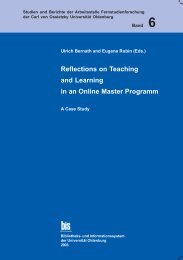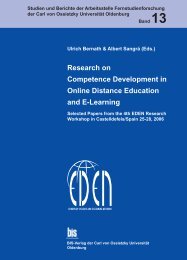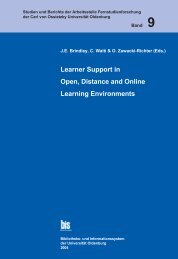Distance Education in Transition - Master of Distance Education ...
Distance Education in Transition - Master of Distance Education ...
Distance Education in Transition - Master of Distance Education ...
You also want an ePaper? Increase the reach of your titles
YUMPU automatically turns print PDFs into web optimized ePapers that Google loves.
Moderat<strong>in</strong>g a Virtual Sem<strong>in</strong>ar<br />
We may consider it an achievement <strong>of</strong> the cont<strong>in</strong>ued pedagogical metacognition dur<strong>in</strong>g<br />
the sem<strong>in</strong>ar when Randy f<strong>in</strong>ishes his <strong>in</strong>tervention by say<strong>in</strong>g: "Two months ago, the<br />
questions (<strong>of</strong> the survey) would have been simply answered, now they require thought."<br />
This is more than adequate feedback for the organizers <strong>of</strong> this sem<strong>in</strong>ar.<br />
Structure <strong>of</strong> Discussions<br />
One <strong>of</strong> the consequences <strong>of</strong> the a-synchronism <strong>of</strong> virtual sem<strong>in</strong>ars is that discussions<br />
cannot be conducted <strong>in</strong> the same way as <strong>in</strong> real world learn<strong>in</strong>g sett<strong>in</strong>gs. In fact, they<br />
differ extremely. First <strong>of</strong> all, cont<strong>in</strong>ued target-oriented debates are subdivided <strong>in</strong>to many<br />
short discussion phases. Spontaneous contributions are not possible. Because every<br />
participant can express his or her views on the issue under consideration at different<br />
times and <strong>in</strong> different sections <strong>of</strong> the sem<strong>in</strong>ar, too many contributions accumulate. The<br />
format <strong>of</strong> the messages and the necessity to formulate and edit the contributions allow<br />
for relatively brief statements only when the students are pressed for time. The students<br />
cannot really expand on issues <strong>of</strong> personal <strong>in</strong>terest or requests for further elaboration. If<br />
the debate <strong>of</strong> a given issue is resumed after some days, it is difficult to position the<br />
contribution, refer it to earlier statements and to re-establish the context. The systematic<br />
<strong>in</strong>vestigation <strong>of</strong> a theme, the step-by-step deal<strong>in</strong>g with sub-questions, the consideration<br />
<strong>of</strong> several aspects brought forward by several participants, the justification and<br />
evaluation <strong>of</strong> arguments and full summaries are difficult to achieve. One student<br />
characterized the discussion <strong>in</strong> a virtual sem<strong>in</strong>ar by say<strong>in</strong>g that it consists <strong>of</strong> a cosmos <strong>of</strong><br />
kaleidoscopic m<strong>in</strong>i-dialogues. Because <strong>of</strong> the importance <strong>of</strong> the scholarly discourse for<br />
the development <strong>of</strong> scientific understand<strong>in</strong>g and communication, the dissolution <strong>of</strong> the<br />
discussion, so typical <strong>of</strong> a real sem<strong>in</strong>ar, must be considered a grave loss and be<br />
deplored.<br />
Can this loss be compensated? Before answer<strong>in</strong>g this question, I should like to refer<br />
aga<strong>in</strong> to the fact that virtual learn<strong>in</strong>g spaces differ radically from real learn<strong>in</strong>g spaces.<br />
This means that we have to adapt to new pedagogical circumstances and possibilities.<br />
We must be open to changes, even drastic ones. One <strong>of</strong> them is to become acqua<strong>in</strong>ted<br />
with an entirely new structure for discussions and the appropriate new learn<strong>in</strong>g activities<br />
– which are possible only <strong>in</strong> virtual sem<strong>in</strong>ars. Here students have to deal with and cope<br />
with a grow<strong>in</strong>g volume <strong>of</strong> varied and multi-faceted messages. In order to be successful<br />
they have to develop skills that differ decisively from listen<strong>in</strong>g to oral contributions and<br />
to enter the discussion now and then. Their ma<strong>in</strong> task is now »read<strong>in</strong>g« and »structur<strong>in</strong>g«.<br />
They have to relate new written <strong>in</strong>formation to previous written <strong>in</strong>formation <strong>of</strong> the same<br />
k<strong>in</strong>d, assemble clusters <strong>of</strong> <strong>in</strong>formation and become familiar with the thread<strong>in</strong>g <strong>of</strong> discussions.<br />
This process can be an <strong>in</strong>dividual one accord<strong>in</strong>g to <strong>in</strong>terests, predilection, and<br />
experiences. Thus, their participation <strong>in</strong> the discussion takes the form <strong>of</strong> work<strong>in</strong>g with,<br />
work<strong>in</strong>g through and structur<strong>in</strong>g grow<strong>in</strong>g accumulations <strong>of</strong> <strong>in</strong>formation. L<strong>in</strong>earity is<br />
substituted by complexity.<br />
Perform<strong>in</strong>g this task requires special <strong>in</strong>tellectual flexibility and an overall view <strong>of</strong> the<br />
processes go<strong>in</strong>g on <strong>in</strong> order not to lose track <strong>of</strong> the discussion <strong>in</strong> various threads. It<br />
demands even some amount <strong>of</strong> creativity. The students are not only supposed to<br />
dist<strong>in</strong>guish themselves by writ<strong>in</strong>g relevant contributions, but much more so by<br />
120





